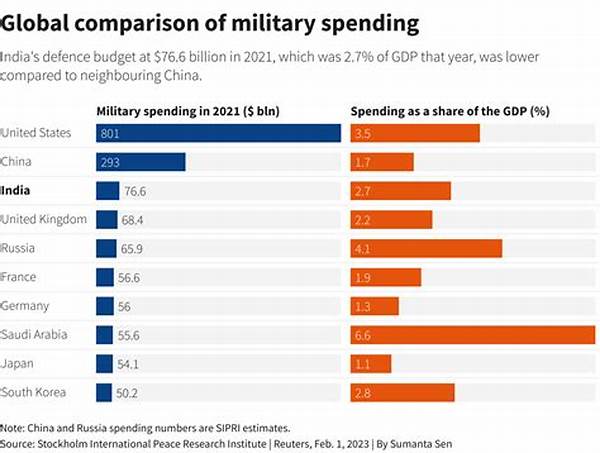The analysis of military expenditure allocation trends is a pivotal aspect of understanding global defense capabilities and national security priorities. Governments worldwide allocate substantial portions of their budgets to defense sectors to ensure preparedness against potential threats. As geopolitical dynamics evolve, military expenditure trends also fluctuate, reflecting strategic shifts and adaptations to new challenges. This article delves into the intricacies underlying these trends, offering insights into the patterns of defense spending and their implications for global peace and stability. With a comprehensive evaluation of historical and contemporary data, this analysis seeks to elucidate the multifaceted nature of military investments and the decision-making processes that drive such allocations.
Historical Context of Military Expenditure Allocation Trends
The study of military expenditure allocation trends over time reveals significant shifts influenced by historical events, technological advancements, and geopolitical tensions. During the Cold War era, for instance, superpowers like the United States and the Soviet Union allocated considerable resources to military development, driven by the arms race and ideological rivalry. As the Cold War concluded, military expenditure trends saw a temporary decline, embodying the optimism of a new world order centered on diplomatic resolutions rather than military confrontations. However, the early 21st century marked a resurgence in defense spending, propelled by new security threats such as terrorism and regional conflicts.
In more recent years, emerging economies have also increased their defense budgets, aspiring to enhance their strategic influence and safeguard national interests. Concurrently, military expenditure allocation trends have been shaped by technological advancements, notably in cyber warfare and artificial intelligence, prompting nations to allocate funds toward modernizing their armed forces. Hence, a comprehensive understanding of historical trends is essential to predict future patterns and their implications for global peace.
Factors Influencing Military Expenditure Allocation
1. Geopolitical Tensions: Escalating regional conflicts contribute significantly to military expenditure allocation trends, as nations seek to bolster defense readiness.
2. Technological Innovation: Breakthroughs in military technology necessitate increased spending to integrate advanced capabilities into defense systems.
3. Economic Capacity: A nation’s economic strength directly influences its ability to allocate resources towards military expenditures.
4. Security Threat Perceptions: Perceived threats, whether from neighboring states or non-state actors, impact military expenditure allocation trends significantly.
5. Political Will: The commitment of a country’s leadership to prioritize defense can shape trends in military budget allocation.
Implications of Military Expenditure Allocation Trends
The implications of military expenditure allocation trends are profound, stretching beyond national borders to influence global stability. Elevated military spending can serve as a deterrent, discouraging potential aggressors and maintaining regional equilibrium. However, excessive focus on defense budgets may lead to fiscal imbalances, affecting investments in crucial sectors like healthcare and education. Furthermore, an arms race fostered by unbridled military expenditure trends could exacerbate tensions, increasing the risk of conflict.
Despite these concerns, judicious allocation of military resources can enhance a nation’s cybersecurity infrastructure, facilitate participation in peacekeeping missions, and strengthen alliances. Strategic investments in defense technologies, such as drones and surveillance systems, offer nations a competitive advantage, promoting stability and deterrence. Thus, the balance between defense expenditure and other national priorities remains a critical consideration in policy formulation.
Challenges in Analyzing Military Expenditure Trends
1. Data Ambiguity: The lack of standardized reporting creates challenges in accurately assessing military expenditure allocation trends.
2. Secretive Spending: Classified military projects contribute to the opacity of defense budget allocations, complicating comprehensive analysis.
3. Economic Fluctuations: Economic instability can lead to abrupt changes in military expenditure trends, affecting predictive accuracy.
4. Political Instability: Regime changes can redefine defense priorities, influencing military expenditure allocation decisions.
5. Technological Disruptions: Rapid advancements necessitate adaptive strategies in military budget allocation, posing challenges for trend analysis.
6. Budget Constraints: Limited resources often force difficult choices in defense expenditures, affecting overall trends.
7. Multilateral Relationships: Military alliances and obligations impact national defense spending patterns, requiring careful analysis.
8. Public Opinion: Social pressures and public sentiment can influence military budget allocations, altering expenditure trends.
9. Unforeseen Threats: Emerging global threats require flexible and responsive military expenditure strategies.
10. Ethical Considerations: Balancing defense needs with humanitarian concerns remains a complex task in military expenditure allocation trends analysis.
Military Expenditure and Economic Impact
A nuanced understanding of military expenditure allocation trends requires an examination of their economic ramifications. While increased defense spending can stimulate economic activities through job creation in the defense sector, it may also lead to opportunity costs, diverting funds from social services and infrastructure development. The intricate balance between maintaining a robust defense posture and addressing social needs remains a pressing challenge for policymakers.
Furthermore, military expenditure allocation trends impact international trade and diplomatic relationships. Nations focused on defense procurement may seek alliances with supplier countries, influencing trade agreements and geopolitical alignments. Therefore, the economic impact of military spending extends beyond national borders, affecting the global economy in multifaceted ways. Understanding these dynamics is pivotal for formulating policies that ensure defense readiness without compromising economic growth.
Strategic Considerations in Military Expenditure Allocation
The formulation of military expenditure allocation trends is inherently tied to strategic considerations. Governments must prioritize defense capabilities that align with national security objectives, geopolitical aspirations, and international commitments. Moreover, the rapid evolution of threats necessitates adaptive strategies, requiring continuous reassessment of military investment priorities.
Strategic foresight and planning are instrumental in optimizing military expenditure allocation, ensuring that limited resources are judiciously utilized to enhance national security and maintain geopolitical stability. Collaborative efforts with allies, investments in intelligence capabilities, and advancements in defense technology are vital components of strategic military expenditure planning. Thus, careful consideration of these factors is critical in shaping trends that support national interests and contribute to global peace.
Conclusion of Military Expenditure Allocation Trends Analysis
In conclusion, military expenditure allocation trends analysis is an intricate process that encompasses diverse factors such as geopolitical dynamics, technological advancements, and economic considerations. A meticulous evaluation of these trends is essential for understanding their implications for national security and global stability. As the international landscape evolves, effective allocation of defense resources remains paramount to safeguarding sovereign interests and fostering international peace.
The study of military expenditure allocation trends also underscores the necessity for sustainable defense spending. Balancing security needs with social and economic priorities is crucial to ensuring holistic national development. Thoughtful and strategic defense expenditure not only fortifies national security but also contributes to regional and global stability, demonstrating the interconnectedness of military investments and broader societal well-being.





